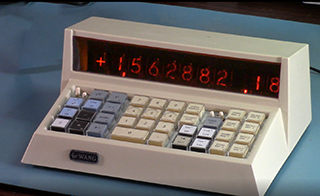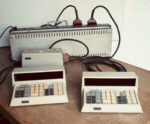 I brought a Wang 360 calculator console back to life with a modern “Electronic Package”. Not only does it emulate the original Wang calculator’s behavior, but it can operate as a nixie clock or as a Reverse Polish Notation calculator.
I brought a Wang 360 calculator console back to life with a modern “Electronic Package”. Not only does it emulate the original Wang calculator’s behavior, but it can operate as a nixie clock or as a Reverse Polish Notation calculator.

The Wang 300 series calculators consisted of an Electronic Package (as Wang called it), where calculations were executed using discrete diode-transistor logic, and up to four keyboard/display consoles. The consoles were basically dumb terminals: they were connected to the Electronic Package (EP) via a 30-conductor cable. The EP scanned the keyboard for key presses and displayed digits on the multiplexed nixie tubes.
I bought this console on eBay. When I got it, the cable to the Electronic Package had already been cut off and discarded. The Electronic Packages show up on eBay from time to time but they’re expensive; people are asking $1,500 to $2,000 dollars. They’re also often broken. They use discrete diode-transistor logic, three different voltage levels, and core memory, so they’re a challenge to repair.

So I designed a modern circuit board that fits inside the console, without altering any of the vintage hardware, and brings the console to life. I wrote an emulator for the original Wang calculator (which, as anyone who has used it can tell you, has some very strange quirks: the display flickers whenever it’s doing multiplication or division, it thinks the natural log of zero is about -41, it allows you to divide by zero, and don’t even get me started on how complicated it is to calculate a formula that has both multiplication and addition in it – but I reproduced all these behaviors). I made it so that when you turn the calculator off, it becomes a nixie clock (it gets the time from GPS satellites, you can configure the display format, the time zone, and the Daylight Saving Time rules, and at midnight it exercises all the nixie digits to avoid cathode poisoning). And, with all due respect to Dr. Wang, since his calculator is actually a real PITA to use, I added a mode where the Wang behaves like a full-blown Reverse Polish Notation calculator, just like the classics from Brand X. That also allowed me to add a lot of features beyond what the original Wang calculator supported.
There’s a lot more information in the video. Check it out:
Here’s an in-depth video about the hardware:
Here’s a manual for the board.
I’d like to thank a few people for their help. Brian White has an excellent write-up of his adventures in repairing a Wang calculator, and it’s been a big help to me. Moreover, he lives just a couple of towns away from me and he was kind enough to let me come over. He tested my Wang console to confirm it worked and helped me figure out how to drive the display. Thank you Brian!
My brother Steve helped my understand the Wang’s internal workings. The Wang relies heavily on a patented method for calculating logarithms (the Wang does multiplication and division by taking the log of the operands, adding or subtracting them, and taking the anti-log of the result). I couldn’t understand the patent’s description of the method, but Steve helped me out with it. Thanks, Steve!
Finally, I owe a debt of gratitude to Mark Palmer. I found him on YouTube, where he posts videos of his vintage hardware and other projects. He has a working Wang calculator and he allowed me to send him about a zillion test cases to run. This helped me figure out some of the Wang’s bizarre behavior well enough to emulate it. Thank you Mark!

Excellent work, and an incredible project to complete! Though not really RPN used with Wang, my guess is Wang’s idea was to follow the operating notation as closely as possible to the Friden EC-130 that had been on the market for a year or two and was already popular in many schools and businesses. The LOCI-2 was lambasted for being too cumbersome to use, and Wang had to do something with the 300’s to make them easier. A little bit of the RPN “feel” combined with adding machine did the trick.